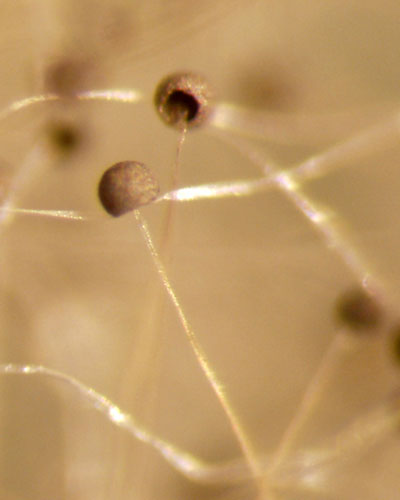July 22, 2016

Study Discovers Molecular Pathways That May Lead to Treatments
Most people don’t think of fungal infections as deadly – they are generally viewed as annoyances – athlete’s foot, for instance.
But for many weakened patients in the hospital, fungal infections can be life threatening. Some experts estimate that tens of thousands of patients die every year from these infections. Recent research has also found that wounded soldiers in Iraq and Afghanistan have sometimes died after fungus from soil is driven deep into their wounds, causing untreatable infections.
Now, a new study by scientists at the University of Maryland School of Medicine (UM SOM) has provided new insights into one of these microbes, the Mucorales fungi, which can cause fatal infections.
The study was published today in the journal Nature Communication. The researchers delineated several key aspects of the fungus that might help researchers develop treatments for the fungus. Right now, there is no way to treat these fungal infections. For example, all of the mucormycosis-causing fungi tested contained several copies of a gene known to be involved in host invasion.

The other lead author is Ashraf S. Ibrahim, PhD, a scientist at LA BioMed, a nonprofit independent biomedical research institute in Los Angeles. Marcus Chibucos, PhD, a research associate at the IGS, also contributed significantly to the study.
There are between 50 and 100 species of the Mucorales fungus. Dr. Bruno and his colleagues compared the genes of 25 of these. The study identified several pathways that are required for mucormycosis to develop in a patient.
Generally the fungus invades the cells of people with weakened immune systems and causes a sometimes-deadly infection known as mucormycosis.
Patients whose immune systems are not working properly are especially at risk. This group includes patients with diabetes, people who have recently undergone transplants or who have suffered wounds. In addition to soldiers wounded in Iraq and Afghanistan, the fungal infections also appeared in some patients hurt in the 2004 tsunami in Indonesia and the tornadoes that occurred in Joplin, Missouri, in 2011.
These infections are considered to be rare, but Dr. Bruno notes that they are probably often overlooked and underreported, and so may be much more common than previously realized.
“There are no vaccines or effective therapies available today to halt the highly fatal mucormycosis infection,” said Dr. Ibrahim. “There is an urgent need for additional research to develop strategies to protect patients with weakened immune systems.”
The researchers say they have identified a pathway that has the potential to be targeted to treat these infections. It appears that these fungi are less able to invade human cells after the inhibition of a protein called platelet-derived growth factor receptor (PGDFR), which plays a key role in cell growth. Dr. Bruno and Dr. Ibrahim are now beginning research to find out whether this protein can be targeted to treat these fungal infections. They suspect that there may be existing drugs, already approved by the FDA that can effectively inhibit PGDFR; this would make the path to finding treatment for these fungal infections much simpler.
“This work is both innovative and exciting,” said UM SOM Dean E. Albert Reece, MD, PhD, MBA, who is also vice president for medical affairs at the University of Maryland and the John Z. and Akiko K. Bowers Distinguished Professor. “It combines “big data” with basic science, and points the way toward what may be critically important clinical solutions.”
About the University of Maryland School of Medicine
The University of Maryland School of Medicine was chartered in 1807 and is the first public medical school in the United States and continues today as an innovative leader in accelerating innovation and discovery in medicine. The School of Medicine is the founding school of the University of Maryland and is an integral part of the 11-campus University System of Maryland. Located on the University of Maryland’s Baltimore campus, the School of Medicine works closely with the University of Maryland Medical Center and Medical System to provide a research-intensive, academic and clinically based education. With 43 academic departments, centers and institutes and a faculty of more than 3,000 physicians and research scientists plus more than $400 million in extramural funding, the School is regarded as one of the leading biomedical research institutions in the U.S. with top-tier faculty and programs in cancer, brain science, surgery and transplantation, trauma and emergency medicine, vaccine development and human genomics, among other centers of excellence. The School is not only concerned with the health of the citizens of Maryland and the nation, but also has a global presence, with research and treatment facilities in more than 35 countries around the world. http://medschool.umaryland.edu/
About LA BioMed
Founded in 1952, LA BioMed is one of the country's leading nonprofit independent biomedical research institutes. It has approximately 100 principal researchers conducting studies into improved diagnostics and treatments for cancer, inherited diseases, infectious diseases, illnesses caused by environmental factors and more. It also educates young scientists and provides community services, including prenatal counseling and childhood nutrition programs. LA BioMed is academically affiliated with the David Geffen School of Medicine at UCLA and located on the campus of Harbor-UCLA Medical Center. For more information, please visit www.LABioMed.org
Contact
Office of Public Affairs
655 West Baltimore Street
Bressler Research Building 14-002
Baltimore, Maryland 21201-1559
Contact Media Relations
(410) 706-5260
